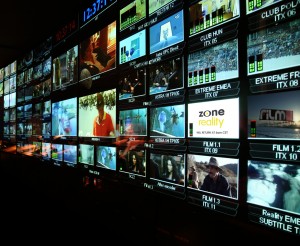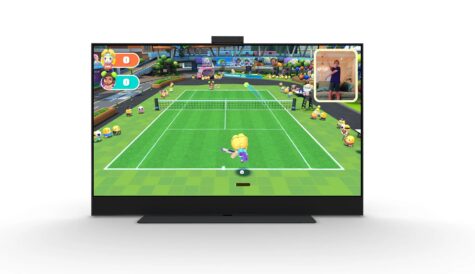Cloud cover: how playout technology is adapting to the multiscreen
 As cloud-based multiscreen TV becomes mainstream, broadcast playout technology is adapting. Anna Tobin reports.
As cloud-based multiscreen TV becomes mainstream, broadcast playout technology is adapting. Anna Tobin reports.
There’s a lot going on up there in the ‘clouds’. The traffic is rising rapidly, the routes that the traffic is being distributed over are diversifying and the loads it has to pick up, drop off and mix en route are becoming ever more complicated.
Playout providers would probably testify that trends revealed in Ofcom’s UK Communications Market Report August 2013 are being near mirrored across the developed world. The regulator and competition authority for the UK communication industries found that: “People are still coming together to watch TV in the living room – 91% of UK adults view TV on the main set each week, up from 88% in 2002 – however, an increasing array of digital media is vying for their attention. Fifty three per cent of adults regularly multi-task with other media while watching TV…transforming the traditional living room of our parents and grandparents into a digital media hub.”
More screens
The providers of that digital media have ever more content to transmit and they have to get that content not only through the traditional broadcast linear chain to TV sets, but they must publish via linear IP and non-linear VOD to tablets, computers, smartphones and games consoles. And there are more screens waiting in the wings, with early adopters eager to get smart spectacles and watches. Broadcasters also have to meet increasingly localised orders for content. A sports broadcast from Berlin, for example, could be ordered for distribution in Italy, complete with various subtitling, language and graphic options, and in Sweden with a whole new set of requirements. That same broadcast needs to be prepared for VOD on numerous devices.
A new mindset needs to develop if all this is to be achieved efficiently and economically says Tom Lattie, vice-president, product management at Harmonic. “Today the playout workflow is very linear in its nature. While this makes sense for linear distribution it is not very efficient for on-demand and file-based workflows. Today, channels are often built in this “traditional” way then recorded for downstream transcoding. As transcode workflows are enhanced to support run lists and secondary events, programmers [should] move to more efficient non-linear workflows for on-demand multi-platform content.”
Whilst all these opportunities have the potential to create enticing new revenue streams, a proven business model for tapping in to this has yet to be devised. “What is clear from the standpoint of broadcast operations is that these additional delivery methods do not have a corresponding increase in revenue,” says Lattie. “As such, broadcasters cannot afford to build separate and bespoke operations for multi-platform delivery, but rather enhance the workflows that they have. Typically, this means they lean more on media management systems in order to more efficiently manage their workflows.”
Rethinking Playout
Historically playout providers have treated the extra screens as just that, supplementary add-ons. Now they recognise that they are no longer a sideshow and often even eclipse the traditional TV viewing experience.
In the past, it was common for a playout service provider to have simplistic content preparation workflows, often receiving ready-to-play content for a given target territory, which made the content hard to re-use, says Peter Elvidge, head of global media management at GlobeCast. “Now it’s more common to manage the content as a kit of parts. We encourage our broadcast customers to provide us with the original master material and allow us to manage the workflow to pass this through their partners to generate local audios, subtitles and legally complied versions. We end up with a rich package of all the media components and metadata, allowing us to automatically transform the content for use on any device anywhere in the world.”
As a result, Elvidge redefines GlobeCast as a content publishing and distribution partner, rather than just a connected playout centre.
Jon Try, vice-president, technology at Chello DMC says that when you have to publish a screen or screens within a screen, things get particularly challenging. “The live side becomes even more interesting when a multi-screen user has the facility to watch more than one channel simultaneously. This complication is all handled within the content delivery mechanism,” says Try. He adds that the workflow for on-demand content is “a little more complicated” as the platform operators will require more metadata about the content.
Preparation is key
To ensure that each file can be adapted for the majority of requirements made on it, it must, from as near the start of the process as possible, be divided up into separate parts so that it can go around ad breaks, have subtitles burnt in, etc. before being transcoded and encrypted. This is a tricky set of tasks, but it can all be efficiently automated at the playout stage.
“Playout is the centre of everything,” says Doron Revivi, chief commercial officer at SatLink Communications. “There is not a lot of difference between storing content for VoD or transmitting live. It’s about preparing the file for various [icitspot id=”113032″ template=”box-story”]products and getting a lot of knowledge on the file. It is then up to the customer how they want it delivered. The most challenging part is manipulating the file correctly. We have a lot of files coming in in different ways. We have to then transcode it to the same file format, which we can go on to send out in any format we want.”
To achieve this, says Elvidge at GlobeCast, you need to break all the content you receive into its component parts: video tracks, audio tracks and subtitle or caption tracks. It is also advantageous to manage these in a relatively small number of standard formats, like AVC-Intra for HD video, and to make sure audio is consistently formatted, he says. “It is then critical to obtain good quality metadata, for example time codes where the main programme material starts and ends, as well as timecodes for commercial break positions. This is so critcal that any incoming metadata needs to be ‘quality controlled’ along with the media.”
To add to the complexities of this process, in many cases multiple languages need to be inserted which arrive from all over the globe at different stages in the content’s usage and it will need to be adapted to suit different rights approvals and local regulations. And, at the same time, there is a growing emphasis on quality across all screens.
“An unexpected consequence of this viewing shift,” points out Bruce Devlin, chief technology officer at AmberFin, “is on the way in which the quality control of up, down, cross and standards conversion is performed. Until recently, most of the QC reviewers were looking for smooth motion and natural look in the pictures. Now there is an expectation that the images will be crisp, clean and free from artefacts, even if the original was in a different frame rate and a different colorimetry. It’s the attention to these little details and preserving those quality aspects throughout the manipulation of the media that can make the difference between good viewer feedback and great viewer feedback, and, therefore, indirectly the advertising revenue. With the introduction of new codecs such as HEVC, it is going to be interesting to see how the automated media manufacturing processes cope.”
Consolidation
Delivering to multiple screens essentially requires transcoding one asset into several assets, which we know is do-able, but with greater industry cooperation and sharing of technology this process should become much easier. “You need to package the content in one place for all platforms,” says Joachim Bergman, head of solutions and operations, broadcast services at Ericsson. To achieve this efficiently and economically, he adds, you need to standardise as much as possible.
It is no secret that in our existing reality the multiscreen universe is chaotic and non-standardised, admits Ziv Mor, chief technology officer and vice-president, business development, RRsat. “This state creates many opportunities for content providers, but it also generates a constant growth in operating costs for these players, where we see more and more media and entertainment companies re-approaching their existing traditional broadcast providers with requests to oversee content management and operation for all screens under the same roof with integration into existing workflows.”
It is likely that broadcasters will increasingly outsource their playout to external operators to benefit from their scale, which will likely lead to greater standardisation. As part of this move, we will also see an increasing reliance on software over hardware. Indeed, Steve Plunkett, chief technology officer at Red Bee Media, says that one of the most significant tech developments in this area over the next couple of years will be a transition away from proprietary hardware-based playout systems to software-based solutions. “These are quicker to deploy, change and offer more flexible operating and licensing models. This is a non-trivial transition that will likely change the fortunes of some established vendors and how the market as a whole is structured,” he says.
Most other industries have been doing this for years, adds Steve Russell, head of product, commercial and architecture, media services at Tata Communications. “The most efficient method is to host the software on generic enterprise IT platforms connected to highly available fast networks in a secure datacenter,” he says. “We are seeing a strong partner model emerging from leading broadcast technology vendors at the forefront of the transition to a software business model. Working with global network operators can ensure that customers experience a combined service model that is compelling from a cost, functionality, security and reliability perspective. Take, for example, the work we’re doing with Harmonic to create a cloud-based broadcast-quality transcoding and delivery service.”
There’s real market demand to reach a global audience with localised content, with the expectation of being able to tune in anywhere and at any time. Global entertainment and sports giants want to leverage their international brands and content, but they want to give this a regional accent. This is where cloud technology comes into its own. “The requirement to handle multi versions, multi channels and different regions, sometimes with different branding and even different business models, along with the evolving technology of internet, cloud and virtualisation will eventually push the playout operation into the virtual and private clouds domain to support better flexibility, scalability and efficiency with managing such operations,” says RRsat’s Mor.
Right moves
As playout providers are now producing work for multiple screens they have also had to take on more of a role in rights control. “For us the biggest challenge in all of this is having to consider the rights management across so many different platforms,” says Paula Mathews, head of media management products, Arqiva. Previously, this was managed by the content provider, “but now we have to worry about multiple variables,” she says. “We have had to reassess the ways we architect things. We have to capture metadata to ensure that media is only going where it is licensed to go.”
At the same time, says Try, “rights holders are still working out how to expand the availability of their content [to different devices] whilst at the same time protecting it.” There is no doubt that playout workload is only going to increase, but costs don’t have to go the same way, says Revivi at SatLink. He believes that the increasing automation of playout will ultimately reduce the cost of starting and running a content channel. “You can now do most of the ‘work’ from anywhere. You can shift the materials on cheap fibre, log on and manage that service on the cloud and it should be cheaper to run as a result.”
No doubt costs will fall as playout operators scale and reposition themselves as global media publishing factories, but this is dependent on the slick convergence of broadcast and IT skills and the organisational changes required to implement it, according to Devlin at AmberFin. “Playout has historically been the link between media owners and revenue, ensuring that content, including commercials, were delivered to viewers reliably. As a result, playout operations have been a key area of investment for media owners and playout organisations have wielded significant power, he says. “Today, each distinct group is simply supporting a part of a publishing portfolio and with these groups working in isolation, media organisations have not been able to take advantage of the efficiency gains of a centrally orchestrated workflow.” There will be casualties, but those companies that keep ahead of the curve will be the ones still being quoted in this magazine in years to come.



